Femoral Head Ostectomy
What is an FHO (Femoral Head Ostectomy)?
A Femoral Head Ostectomy is a surgery performed on a diseased or damaged hip joint. The goal is to re-establish pain-free mobility in the hip joint by removing the head and neck of the femur. The adjoining muscles and, eventually, fibrous tissue help to provide stability and function in the new “false-hip” joint.
Situational Awareness
The FHO is a very useful procedure in small animal practices. It can be a LIFE SAVING surgery for some pets.
The FHO seems to have a bad reputation with some surgeons; it is sometimes thought of as a less worthy procedure. This may have been true 20 years ago, but with the advent of rehabilitation practice in small animal surgery, the outcomes are very different. Patients with an FHO can have very good to excellent outcomes. The keys to success with this procedure are post-op rehabilitation and case selection.
It is my opinion that this procedure is markedly underutilized in Small Animal Practices. A practitioner with an interest in surgery can learn to do the FHO successfully. The special instrumentation necessary is minimal and not expensive, and the post-operative rehabilitation, although crucial, is not technically difficult. It’s time to stop euthanizing kittens and puppies with a hip fracture! Learn how to do an FHO
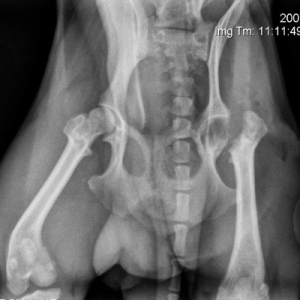
Get ready to Perform an FHO:
All the information you need.
Fully narrated surgical videos.
In depth guide and more.
Fully narrated surgical videos.
In depth guide and more.
This content is designed for veterinary professionals. If you are a pet owner, please consult your vet if you have any questions about a surgery.
Pre-Surgical Considerations:
- Good, properly labeled (L/R) radiographs
- Preoperative blood work as NSAIDs are recommended for 2-4 weeks (maybe longer) after surgery.
- Your client is committed to post-operative care/rehabilitation.
What the client needs to know:
- The dog will need to consistently have at least 2 daily walks (slow controlled leash walks) with the focus being on the dog using the limb.
- Daily stretches and Passive Range of Motion (PROM) exercises are also necessary.
- The first 2 weeks can be a bit more difficult as the exercises and stretches will be new/different for the client and patient.
- The outcome for these patients is very good to excellent in over 90% of the cases. This means that the pet should be able to be active, pain-free and drug-free.
Step by step FHO
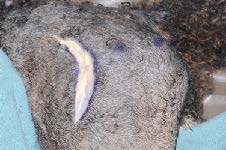
- Figure 1
A curved skin incision is made just in front of the greater trochanter and femur
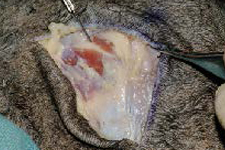
- Figure 2
The subcutaneous tissues are cleared until the division between the TFL and superficial gluteal muscle (scalpel blade) as well as the biceps femoris (right) and superficial fascia on the left can be identified and the fascia incised along that line.
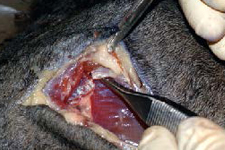
- Figure 3
The middle gluteal has been pushed dorsally to expose the tendon of the deep gluteal, which is then been partially cut.

- Figure 4
The stifle is externally rotated and an incision is made at the origin of the vastus muscle, very close to the femoral neck.

- Figure 5
The vastus muscle is elevated off of the bone to expose the femoral neck and proximal metaphysis.
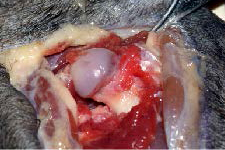
- Figure 6
The head is luxated and with the stifle externally rotated, an osteotome is placed from inside the greater trochanter to the lesser trochanter, perpendicular to the femur.
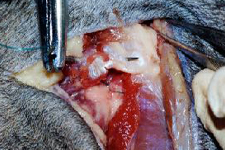
- Figure 7
The tendon of the deep gluteal muscle is sutured with a mattress stitch.

- Figure 8
The fascial layer, subcutaneous layer and skin are closed in a routine manner. It is easiest to close the fascia starting distally as the layers are readily identified
Get ready to Perform an FHO:
Preferred instrumentation:
- Sharp osteotomes (15-18mm) and a mallet
- Hatt spoon (medium size)
- Retractors: 5” Gelpi or Weitlainer
- Review the anatomy and watch the surgery video before beginning.
Post-operative considerations:
- Use NSAIDs (providing no contraindications) daily for 4 weeks post-op
- Start slow leash walks, stretches and PROMS within 24hours of surgery
- Recheck patient at 2, 4 and 8 weeks post-op, at least.
- Patient should be weight bearing consistently by 2 week recheck (video)
What you get when you register:
- A full understanding of the relevant anatomy. This is a key to creating a successful approach
- A fully narrated pictorial description of the surgery with emphasis on
- Creating an approach that will maximize the exposure of the femoral neck
- Understanding how to know if the osteotomy is adequate and how to correct.
- A fully narrated video of the surgery being performed on a patient.
- Detailed post-operative care instructions with a complete rehabilitation program with which you can guide your client.
- How to manage the cases that don’t go well
- How to select cases
- Which patients require this procedure.
Price: $450 CAD
Q & A
How long is the recovery from a FHO?
With acute cases, many patients are back to pre-injury status by 6-8 weeks after surgery (with diligent post-op exercise program). The chronic cases (such as marked hip OA patient) can take closer to 12-15 weeks.
Can the pet jump, walk and play normally afterwards?
Yes, the goal of the surgery and rehabilitation program is to return them to pre-injury activity level drug-free. If specific activities are desired (eg: fly ball activities), then they should be incorporated into the rehabilitation program at the appropriate time.
Subscribe to our newsletter and receive 15% off a workshop of your choice!
Workshops & Courses
Blog
 The Secret to having the Bandage stay Above the StifleJuly 3, 2024 - 1:44 pm
The Secret to having the Bandage stay Above the StifleJuly 3, 2024 - 1:44 pm Common Mistakes made by Veterinarians when doing the Drawer TestJune 26, 2024 - 9:22 am
Common Mistakes made by Veterinarians when doing the Drawer TestJune 26, 2024 - 9:22 am Burying the end knot in a continuous subcutaneous suture patternJune 19, 2024 - 7:35 pm
Burying the end knot in a continuous subcutaneous suture patternJune 19, 2024 - 7:35 pm Creating Donuts for your BandagesJune 12, 2024 - 3:15 pm
Creating Donuts for your BandagesJune 12, 2024 - 3:15 pm The Knotless Suture PatternJune 5, 2024 - 2:45 pm
The Knotless Suture PatternJune 5, 2024 - 2:45 pm

